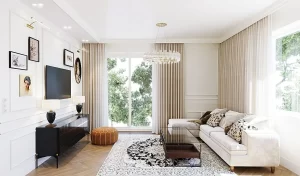Creative Accent Wall Ideas to Transform Any Room

An accent wall is a great way to add a splash of personality to your home. It can be as simple as a coat of paint or as complicated as a mural.
For a bold look, try color blocking. Try using geometric shapes like triangles or chevrons for an easy-to-create artistic look.
1. Painting
When most people think of accent walls, they immediately picture a single wall in a bold shade like red or yellow. But there are other ways to paint an accent wall that can bring out a room’s character.
Painting with a pattern, design or stripe is a great way to add texture and dimension. For example, a pinstripe accent wall can create visual balance and add an elegant touch to any space.
A painted floral accent wall adds a feminine feel to a bedroom. This look is also great for those who aren’t comfortable with wallpaper but want a fresh, design-forward look.
If you’re a renter or have little ones with changing tastes, decals are a stress-free option for creating an accent wall. Choose a nature-inspired motif for a relaxing vibe, or opt for a geometric design for a more modern aesthetic.
2. Wallpaper
A popular accent wall idea, wallpaper creates a bold statement in any room. Choose from a wide variety of patterns and styles. If you’re unsure where to start, consider your space’s existing furniture and layout.
If you love the idea of wallpaper but don’t want to outfit a whole room, try papering just one wall. It’s a great way to get the look you’re after on a budget that fits your needs.
You can also opt for wallpaper with trimmable details to make a personalized statement. Organic textures, grasscloth material and plaid prints are all options that you can cut into shapes to create a unique, personalized style for any room. For example, this floral patterned wall is trimmed with contrasting colors and shapes to match the room’s theme.
3. Decals
Whether you’re a renter, short on time or simply want to avoid the headache of painting, decals are a stress-free way to let your creative flag fly. The selection of styles is massive, making it easy to find one that suits your personality and style.
If you’re a fan of wallpaper but are hesitant to go floor-to-ceiling, consider adding molding in the same pattern as your chosen design. This simple yet stylish approach, as seen on this accent wall by Bless’er House, will add classically inspired dimension without the fuss of a full-room application.
Embrace texture by incorporating brick or salvaged wood paneling into your accent wall. These natural materials add depth and dimension to any room, and work especially well if your home has a fireplace or high ceilings.
4. Wood Paneling
Wood paneling adds texture and warmth to a room and can be painted in a wide variety of colors. It works well in traditional and rustic homes, but it can also be used in modern spaces to create a warm accent. Narrow wood slats installed vertically in a pattern like this one in the bathroom designed by Lauren Shaver of Bless’er House make a bold and striking statement that looks fresh and modern.
Stencils and wall decals are another easy way to put a design on an accent wall. Look for designs that can be changed easily when the mood strikes–like the botanical patterns featured in this bedroom designed by Colleen Simonds or sports logos and lettering that work well in a mancave or home bar.
5. Rock Climbing Wall
A rock climbing wall is a great way to transform a space and give kids a fun and exciting activity that helps with their motor skills and physical fitness. This wall designed by Odbert and built by Baker is floor-to-ceiling and features climbing holds that can be rearranged to increase or decrease the difficulty level.
To build your own rock climbing wall, start by identifying the area you want to cover. Then, mark the studs on the wall with a stud finder. Cut plywood to fit the frame on the wall, making sure it covers all studs. Make sure the plywood isn’t touching electrical outlets or HVAC ducts.
Next, use a hammer to screw in t-nuts into the plywood at each point that will be used for handholds. Then sand the edges of the plywood and seal it to protect against wear and tear.







